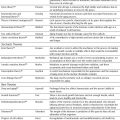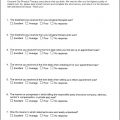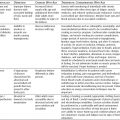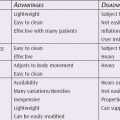LEARNING, MEMORY, AND INTELLIGENCE
PEARLS
❖ Learning is defined as the acquisition of a new skill or information through practice and experience, whereas remembering is the retrieval of information that has been stored in memory.
❖ Encoding and retrieval problems are the cause of memory difficulties in older adults, and instruction in organizing, slower pacing, and verbal and visual associations can improve performance.
❖ Problem-solving ability appears to decline with age and may be due to education level and fluid intelligence. Training can improve older patients’ problem-solving abilities; however, they may not transfer these strategies to problems encountered in real life.
❖ Memory performance of healthy older adults can be improved through memory training.
❖ Variables that positively influence learning for the older person are the following:
- Orderly environment
- A supportive approach by the therapist with much positive reinforcement
- A highly organized presentation of material (ie, a simple, concrete, step-by-step information presentation)
- The appropriate rate of presentation of information
- Choosing meaningful tasks
- The use of memory strategies
- Ample time for repetition and practice
❖ Depression, anxiety, and motivation will influence learning and memory abilities.
❖ One is never too old to learn.
Elders of the tribe were once considered teachers, the founts of wisdom. Today, little respect is given to the experiences of a lifetime, and myths perpetuate the notion that learning abilities and memory capabilities decline with age. On the contrary, in our society, older individuals must learn new skills as new technology alters basic systems of communication, transportation, finance, and recreation on nearly a daily basis. As values change, societal rewards change, and new learning is required.
Learning means the acquisition of information or skills, and it is usually measured by looking for improvements in task performance. When people improve their performance at a given intellectual or physical task, we say that they have learned. Studies of performance in older individuals indicate a decline with age. Clearly, there are a number of factors other than learning ability that affect performance. Some of these include physiological responses, physical health status, pathology, depression, and motivation. In practice, it is extremely difficult to separate the components of performance in order to examine the influence of learning ability, although a number of studies have attempted to do so. Despite evidence that other factors contribute to the decline in task performance, most researchers still attribute part of this decline to a diminished ability to learn new tasks or acquire new information with age.1–6
All age groups can learn. Older individuals just require more time. Tasks that involve manipulation of distinct and familiar symbols or objects, unambiguous responses, and low interference from prior learning are particularly conducive to good performance by older individuals.7–9
At various points in time, different approaches to the study of learning and memory have been dominant. In the 1960s, the associative view of learning was most popular. In the 1970s, theories on information processing or conceptual learning were established as the mode for learning and memory. Now, a growing emphasis in learning theories concerns a contextual approach.10 Thus, it is important to briefly review research on learning and memory from each of these approaches.
Learning and memory are closely related concepts. People must learn before they can remember, and learning without memory has limited utility. Learning is often assessed by memory tasks. “How much have you learned?” is translated to “How much do you remember?” Learning is defined as the acquisition of a new skill or information through practice and experience. Remembering is defined as the retrieval of information that has been stored in memory.10
The general learning/memory system involves 3 processes: acquisition, storage, and retrieval. Memory is often discussed in terms of information—how you put information into the system, how you store it, and how you retrieve it. This is the approach of modern information processing theories, and, in this view, learning is part of memory (ie, the acquisition, registration, or encoding phase).
When adding the dimension of age, there are many questions that arise. How do learning abilities change? How does memory change? Does it fade? Do old people forget new things and remember the past? How do societal demands affect learning and memory?
ASSOCIATIVE LEARNING
Based on the assumption that learning and memory involve the association of ideas or events that occur together in time, the associative learning theory involves a stimulus-response bond, and paired association is the most commonly used mode for testing memory using this theory. The task is to learn an association between 2 commonly unrelated items, such as basket and therefore or orange and until. The participant is first presented with 2 unrelated words, and the subsequent task is to give a correct response to each stimulus word as it appears alone. The ability to recall a paired stimulus represents the contents of memory. There are several factors that appear to influence the amount of information that can be processed with increasing age, including the pace of learning and the environment in which learning occurs, which may be influenced by cautiousness, anxiety, and interference from previously learned information.
The pace of learning is the speed with which a task is performed and is one variable known to affect older learners more than young ones. The pace of learning can be manipulated in 2 ways. The anticipation interval is the time allotted for a response. Older participants perform poorly when this interval is short and do much better when they are given more time to respond.3,11 Younger participants also improve as the anticipation interval increases but less than older participants. If a method called self-pacing is permitted (ie, if learners are allowed as much time as they want), older participants improve in the number of correct responses they are capable of giving. The second element of pacing in paired associative learning is the time the pair of items is presented for study. This period is referred to as the study time or inspection interval. Increasing the study time also improves performance by older learners, although old and young participants have been shown to benefit equally from more time.2,12 Again, if self-pacing is allowed, older participants benefit more than younger participants.13
The ability to perform associative learning tasks may be affected by variables such as cautiousness, anxiety, and interference. These factors are often associated with errors of omission (not responding) or errors of commission (responding incorrectly). Errors of omission occur most often in fast-paced associative learning situations (rather than errors of commission). Errors of omission are reflective of cautiousness or a reluctance to venture a response unless one is absolutely certain of its accuracy. It has been suggested by researchers that the poorer performance of older adults, as reflected in omission errors, is a function of their being more cautious.10,13
To overcome cautiousness, or test this hypothesis, experimenters have requested or demanded responses be made, even if they are wrong. This failed to improve the learning rate of older participants or to reduce the number of errors of omission.14 However, in another test of the cautiousness hypothesis, a small monetary reward was given for each correct response, each incorrect response was also rewarded at a slightly lower value, and the absence of a response received no reward. In this situation, older learners significantly reduced the number of errors of omission,15 which suggests that older learners could do better if they took a few more chances.
One hypothesis regarding the poorer performance of older adults on paired associative learning suggests that anxiety affects performance.16,17 The influence of mental practice and observation of others doing an activity had a significant impact on cognitive function and subsequent motor performance.17
A final hypothesis suggests that in some instances of associative learning, older adults are more susceptible to the effects of interference from prior learning. When one word is frequently associated with another word in everyday situations, such as dark–light and water–ocean, the pair is said to have high associative strength. When one word is infrequently associated with another, such as dark–fast and water–book, the pair has low associative strength. If the associative habits of older individuals are more established through a greater number of years of experience, it follows that the age-related difference should be least for high associative pairs.13 Older adults appear to be more handicapped when learning and recall involve forming associations that are contrary, or in competition with, previously learned verbal associations.
Salthouse13 conducted studies to determine the mechanisms by which processing speed contributes to the relations between adult age and associative learning. The results of these studies indicated that increased age was related to poorer associative learning largely because of a failure to retain information about previously correct responses. This, in turn, was related to the effectiveness of encoding briefly presented information in an associative memory task, which was related to measures of processing speed. It was suggested that age-related decreases in speed of processing lead to less effective encoding or elaboration, which results in a fragile representation that is easily disrupted by subsequent processing.13
Judging from studies of associative learning, the rate of learning slows gradually through the adult years. Only after the age of 65 does one’s learning become demonstrably poorer than that of young adults. The nature of the age deficit remains unclear. Older participants profit from a slower pace of learning much more than do young adults. Moreover, the older learner may get too anxious or cautious or may encounter interference from previously learned associations.
INFORMATION PROCESSING
How information is processed has to do with the older adult’s learning style, which is unique to each learner. Information processing has to do with the typical manner in which an individual receives, retains, and retrieves information as well as how the individual responds emotionally in a learning experience. The term information processing as a means of learning grew from analogies with computer operations and has become a prominent theory in discussions of memory and perception. It involves associative, conceptual, and contextual learning. Information processing is the mechanism through which an individual processes, stores, and remembers events, tasks, lists, and the like. It involves the wiring of the human hard drive—the brain.
In an interesting study by Spitzer and associates,18 functional magnetic resonance imaging, in conjunction with carefully designed, psychometrically optimized stimulation procedures (eg, word pairs, lists of words, and color discrimination tasks), was used to investigate the relationship between brain activation and the processing of word associations. A semantic discrimination task of word-pair similarity selectively activated the left frontal and left frontotemporal areas. Cortical activation was decreased during language activities but highly active when an individual was performing a color similarity task. A similar study19 used functional magnetic resonance imaging to identify cortical areas involved in category learning by prototype abstraction. Older participants studied 40 dot patterns that were distortions of an underlying prototype and were asked to make yes or no category judgments regarding the objects depicted by the dot patterns. Activity in 4 cortical areas correlated with the category judgment task. A sizable posterior occipital cortical area exhibited significantly less activity during processing of the categoric patterns than during processing of noncategoric patterns. Significant increases in activity during processing the categoric patterns were observed in left and right anterior frontal cortex and right inferior lateral frontal cortex. Decreases in activation of the visual cortex when categoric patterns were being studied suggest that these patterns could be processed in a more rapid or less effortful manner after the prototype had been learned. The researchers suggest that increases in prefrontal activity associated with processing categoric patterns could be related to any of several processes involved in retrieving information about the learned exemplars.19
The performance of complex motor tasks, such as rapid sequences of finger movements or lower extremity sequencing activities, can be improved in terms of speed and accuracy over several weeks by daily practice sessions.5 This improvement does not generalize to a matched sequence of identical component movements nor to the contralateral extremity. In a study by Karni and colleagues,5 the underlying neural changes of learning of complex motor tasks was studied using functional magnetic resonance imaging of local blood oxygenation level–dependent signals evoked in the primary motor cortex (M1). Before training, a comparable extent of M1 was activated by both upper and lower extremity sequences. However, 2 ordering effects were observed: repeating a sequence within a brief time window initially resulted in a smaller area of activation (habituation) but later in a larger area of activation (enhancement), suggesting a switch in the M1 processing mode within a fast learning session. By week 4 of training, concurrent with asymptotic performance, the extent of cortex activated by the practiced sequence enlarged compared with the unpracticed sequence, irrespective of order (slow learning). These changes persisted for several months. The results suggest a slowly evolving, long-term, experience-dependent reorganization of the older adult M1, which may underlie the acquisition and retention of the new motor skill.5
Cortical functions concerned with the execution of skilled movements can also be studied through complex interactive tasks. The learning of skilled performance tasks offers the greatest amount of information about the electrophysiological components reflecting preprogramming, execution of the movement, and control of the results. Overall, these components are indicated as movement-related brain macropotentials (MRBMs). Among them, Bereitschaftspotential reflects cerebral processes related to the preparation of movement, and skilled performance positivity reflects control processes on the result of performance. There is some evidence supporting a training effect on MRBMs, but less clear is whether long-term practice of a skilled activity could modify learning strategies of a new skilled task.20 Fattapposta and associates20 recorded MRBMs in older participants trained for a long time to perform a highly skillful activity (ie, sequencing dancing steps) and compared electrophysiological brain activity to a group of older control participants without any former experience in these skilled motor activities. Their findings demonstrated the existence of a relationship between preprogramming and performance control, as suggested by a decrease in the Bereitschaftspotential amplitude and an increase of the skilled performance positivity amplitude in the presence of high levels of performance. Long-term practice seems to develop better control models on performance that reduce the need of a high mental effort in preprogramming a skilled action.20
CONTEXTUAL LEARNING
Associative learning is often supported by the individual placing some contextual meaning to lists of words, activities, or other learning endeavors. For example, if an important piece of information is presented in bold type, it is more likely to be perceived as important because its importance has been stressed through visual intonation. In other words, learning occurs because the information has been presented in context.
In a study by Naveh-Benjamin and Craik,21 memory for words and the font in which they appeared (or the voice speaking them) were compared in younger and older persons to explore whether age-related differences in episodic word memory are due to age-related differences in memory for perceptual-contextual information. In each of the experimental sessions, young and old participants were presented with words to learn. The words were presented in either one of 2 font types, or in one of 2 male voices, and participants paid attention either to the fonts or voices or to the meaning of the words. Participants were tested on both work and font or voice memory. The results showed that younger participants had better explicit memory for font and voice memory and for the words themselves but that older participants benefited at least as much as younger people when perceptual characteristics of the words (eg, italics, bold, or tone of voice) were used. This study concluded that there was no evidence of an age-related impairment in the encoding of perceptual-conceptual information.21 This is an important finding for geriatric rehabilitation professionals. Much of the printed or spoken information we provide for our older patients/clients could conceivably be learned better if it were presented in a perceptual-contextual format.
In a study by Spencer and Raz,22 age-related differences in memory for facts, source, and contextual details were examined in healthy young (18- to 35-year-old) and old (65- to 80-year-old) volunteers. In all tested memory functions, decline over time was greater in older adults than in the young. A time-dependent increase in the prevalence of source amnesia errors was clearly associated with old age. Contrary to other studies, measures of frontal lobe functions did not predict source memory.22 Nevertheless, some of these putative frontal function measures were related to memory for contextual details. The number of perseverative responses on testing was inversely related to performance on both factual and contextual memory tests, but the association with contextual memory was stronger. Difficulties with response selection predicted poor contextual memory in young but not in old adults.22
In a subsequent study, Spencer and Raz23 reviewed the evidence of age differences in episodic memory for content of a message and the context associated with it. Specifically, the authors tested a hypothesis that memory for context is more vulnerable to aging than memory for content. In addition, the authors inquired as to whether effort at encoding and retrieval and type of stimulus material moderate the magnitude of age differences in both memory domains. The results confirmed the main hypothesis—age differences in context memory are reliably greater than those in memory for content. Tasks that required greater effort during retrieval yielded larger age differences in content but not in context memory. The greatest magnitude of age differences in context memory was observed for those contextual features that were more likely to have been encoded independently from content.23 The possible mechanisms that may underlie age differences in context memory, as suggested by these researchers, are attentional deficits, reduced working memory capacity, and/or a failure of inhibitory processing. The findings of the Spencer and Raz studies22,23 are substantiated by numerous other studies.24–27 The major clinical implication of these findings is that older humans overwhelmingly seek, create, or imagine context in order to provide meaning when presented with information. The importance of this is discussed further in a subsequent section of this chapter in relationship to teaching strategies for older adults.
HUMAN MEMORY
There are many myths about the effects of aging on memory. For example, people are supposed to forget things they have recently learned, but memories from the distant past are supposed to be clear and vivid, sometimes startlingly so. Early learning also appears to have a significant impact on an older individual’s resourcefulness for both verbal and physical skills in later life.1,8,9
Memory is closely related to both intelligence and learning since remembering is part of the evidence of learning and learning is part of the measurement of intelligence. For example, if a person does not learn, that person has nothing to remember. Conversely, if the individual cannot remember, there is no sign of that person having learned.28
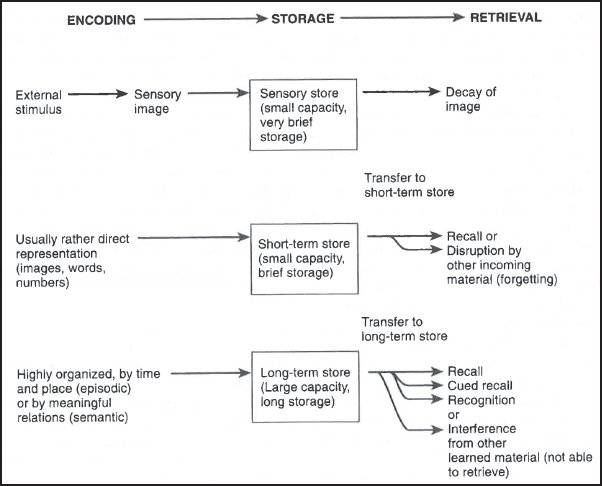
Figure 18-1. Stages of memory registration, retention, and recall.
There are essentially 4 types of memory. Short-term or immediate memory involves recall after very little delay (as little as 5 seconds up to 30 seconds). Recent memory involves recall after a brief period (from 1 hour to several days). Remote memory refers to the recall of events that took place a long time ago but have been referred to frequently throughout the course of a lifetime. Old memory refers to recall of events that occurred a long time in the past and have not been thought of or rehearsed since.9
Regardless of type, there are 3 stages of memory: registration (encoding), retention (storage), and recall (retrieval). Registration refers to the recording of learning or perceptions and is more commonly referred to as encoding. In concept, it is analogous to the recording of sound on a tape recorder. Retention refers to the ability to sustain registration over time. Recall is retrieval of material that has been registered and retained. Obviously, in any type of memory, a failure at any one of these stages will result in no measurable memory. See Figures 18-1 and 18-2.
PROBLEM SOLVING
Many of the learning and memory tasks described in previous sections involved relatively simple problems. Another type of cognitive activity, problem solving, is more complex and may involve aspects of learning and memory not previously discussed. Problem solving requires that a person assess the present state of a situation, define the desired state (or goal), and find a way to transform the present state to the desired state.29
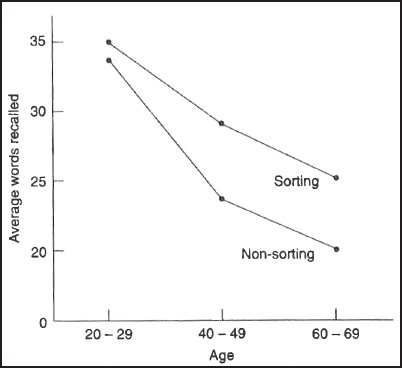
Figure 18-2. The average number of words learned as a function of age. Prior to learning, about half of the participants carried out a sorting task designed to aid in organizing word lists; the rest of the participants performed a task that did not involve sorting. (Reprinted with permission from Hultsch D. Adult age differences in free classification and free recall. Dev Psych. 1971;4:338-342.)
The process of solving a problem has been broken down into 4 steps.30 The first step is to understand the problem, which involves gathering information on the problem and identifying its important elements. The second step is to devise a plan using past experience for guidance. The use of a relevant strategy would ensure that one devises an efficient plan. The third step is to carry out the plan, and the final step is to review what has been done (ie, was the problem solved?).
There are many types of studies that address problem solving from a “laboratory” perspective (using prefabricated laboratory situations that do not necessarily duplicate problems encountered in real life). One such mode of testing is termed concept attainment. In concept attainment tasks, items in a set are divided into 2 subsets in accordance with some characteristics or rule. The participant demonstrates mastery of the rule by distinguishing the items that reflect the rule from those that do not. An example of this would be “choose the red circle; do not choose the green circle.” Another example is presenting meal content lists with the rule that certain food types may induce illness and having the participants identify those meals that would make them ill following consumption. A number of studies of this type, in which performance of younger and older adults was compared, found that the old solved fewer problems than the young.31–33 Some of the difficulties encountered were that older participants failed to ignore irrelevant information and tended to fixate on useless hunches.33 Although older people do not spontaneously use effective strategies, several training studies have found that their performance could be improved with brief training procedures.34,35
Twenty Questions is another means of testing problem-solving abilities. In this type of task, the participant is presented with an array of pictures or words, only one of which is the correct choice. The task is to determine the correct choice by asking less than 20 questions that can be answered with a “yes” or “no.” The most efficient strategy is to ask questions that are constraint seeking (eg, “Is it a vegetable?”), each of which eliminates a set of possible answers. Asking questions that refer to only one item is inefficient. Again, older adults tend to do less well on these tasks than younger groups,36 but their performance improved significantly after training in the use of constraint-seeking questions.
The Piagetian theory has been applied to problem-solving measurement as well. The Piagetian theory assumes that concrete operational abilities (the ability to think logically about concrete or tangible problems), such as classification and conservation (the recognition that the amount of matter does not change when it is rearranged), develop during middle childhood and that formal operational abilities (the ability to think logically about hypothetical situations or problems) are achieved in adolescence. Do these abilities decline in old age? One hypothesis suggests that operational abilities decline in reverse of the order in which they develop.9,37,38 In other words, formal operational thought would decline before conservation. Studies of performance by older persons on various Piagetian tasks have yielded mixed results. Some show that older adults do less well than younger people39; others find no age differences in formal operational tasks.40 Success is positively correlated with higher levels of education and higher intelligence scores. Training has been shown to improve performance by older adults as well.
In summary, these studies suggest that there are age differences in problem-solving abilities and older adults do less well on a number of types of tasks. Several explanations have been offered. It may be that problem-solving ability is a function of educational level, fluid intelligence, or both, rather than aging per se. These factors, in turn, may reflect cohort differences. Additionally, brief educational training has been shown to improve all types of problem solving discussed.41 This suggests that older adults possess the competence to perform the tasks but do not spontaneously use the necessary strategies. Even after training, older adults may not transfer the use of these strategies to the problems encountered in real life.
INTELLIGENCE
When considering intelligence, potential ability and actual ability are implied. In practice, however, measured ability is always dealt with. Thus, intelligence, as it is studied conceptually by psychologists, has 3 aspects: potential intelligence, actual intelligence, and measured intelligence. This discussion will center around age changes in measured intelligence.
Measured intelligence is actual mental ability (ie, measured performance of basic cognitive abilities) defined in terms of responses to items on a test. Yet, no matter how extensive or well prepared a test is, there is always a margin of error in its measurement of actual mental ability. The most frequently used test in studies of adult intelligence and age-related changes is the Wechsler Adult Intelligence Scale (WAIS).
Intelligence quotient (IQ) is a test score that is compared with the normal or average score of 100. When the WAIS is used for adults aged 20 to 75 years and older, there is an age factor built into the determination of what is normal. In Figure 18-3, the heavy black line indicates the mean raw scores on the WAIS by age. Note that measured performance peaks about age 25 and declines thereafter, particularly after age 65. In scoring measured performance, a handicap or advantage is built into the WAIS IQ score to control for age. There could be a 40-point difference between the score at age 25 and the score at age 75, and yet the IQ score would be the same. The importance of this is that the most frequently used test of mental ability incorporates an assumption that a 40-point drop in score from age 25 to age 75 is normal.42
However, in practical terms, the average decline with age in WAIS scores masks a large amount of individual variation. Any given older person might have an extremely high IQ even when compared with the young. In fact, the correlation between age and IQ is not particularly high, only around –0.40. This means that if the odds against predicting the IQ score were 10 to 1, then knowledge of age would reduce these odds to 6 to 1, not a particularly stunning reduction.
Intelligence testing does not measure a single ability but rather a set of abilities. Broadly, the WAIS yields separate scores for verbal and performance IQ. The WAIS includes subtests measuring information, vocabulary, comprehension, arithmetic, similarities, digit span, picture completion, object assembly, block design, picture arrangement, and digit symbol tasks.42 Older participants do best on the information subtest and worst on the digit symbol subtest. The subtests can be broken into 2 sets: one set dealing with verbal ability and the other dealing with performance ability. Older people consistently do better on the verbal tests than they do on the performance tests. Subtest patterns on the WAIS indicate that stored information and verbal abilities are sustained in old age at a much higher level than are psychomotor-perceptual-integrative skills.42,43 Of relevance here is that most of the performance subtests are timed, whereas many of the verbal subtests are not. Timed tests may be influenced by reaction time, which shows an age-related decline.
There are a number of factors that influence age changes in IQ. Perhaps the most important is the individual’s initial level of function. People with scores in the 95th percentile (ie, with scores high enough that 95% of all scores fall below theirs) show a leveling off in vocabulary scores between the ages of 20 and 30. Thereafter, these individuals scores show a plateau or a slight rise with advancing age.44 On the other hand, people in the 25th percentile show a marked decline in vocabulary scores after the age of 30. This suggests that those with a stronger verbal base to begin with continue to acquire verbal intelligence as the years progress, and those with a weaker verbal foundation initially show a progressive decline in ability as the years go by.
Performance on an intelligence test is closely related to such factors as motivation, anxiety, and cooperation. An environment producing anxiety or a poorly motivated or uncooperative individual will prevent accurate measurement of what that individual is actually capable of accomplishing intellectually.
Another factor that has great influence on performance on an intelligence test is the level of education; the higher the educational level, the higher the test scores. It is difficult to determine whether intelligence or education comes first, but they are highly correlated.
IQ is also affected by the health status of the individual being tested. Suboptimal levels of health have been shown to have a negative influence on performance on IQ tests. In fact, it has been hypothesized that rapid declines in IQ after the age of 65 could very likely be the result of poor health. Arteriosclerosis has been correlated to markedly decreased scores.
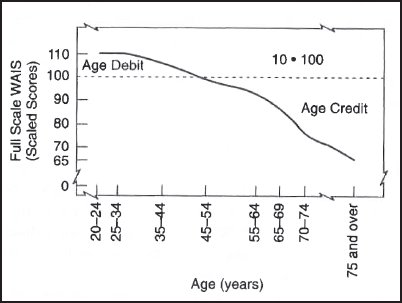
Figure 18-3. Full scale Wechsler Adult Intelligence Scale scores as a function of age. (Reprinted with permission from Botwinick J. Cognitive Processes in Maturity and Old Age. New York, NY: Springer; 1967:3.)
Stay updated, free articles. Join our Telegram channel

Full access? Get Clinical Tree


